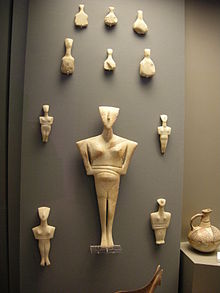- Cycladic art
-
This article is part of the series on: Greek Bronze Age Cycladic art - Minoan art Mycenean art
Art in ancient Greece Archaic Greek art - Classical Greek art
see also: Greco-Buddhist art
Medieval Greece Byzantine art - Macedonian art Post-Byzantine Greece Art in Ottoman Greece - Cretan School Heptanese School
Modern Greece Art in modern Greece - Munich School Cycladic art encompasses the visual art of the ancient Cycladic civilization, which flourished in the islands of the Aegean Sea from 3300 - 2000 BCE. Along with the Minoans and Mycenaeans, the Cycladic people are counted among the three major Aegean cultures. Cycladic art therefore comprises one of the three main branches of Aegean art.
Contents
Neolithic Art
Almost all information known regarding Neolithic art of the Cyclades comes from the excavation site of Saliagos off Antiparos. Pottery of this period is similar to that of Crete and the Greek Mainland. Sinclair Hood writes: “A distinctive shape is a bowl on a high foot comparable with a type which occurs in the mainland Late Neolithic" (Hood 28).
Early Cycladic Art
Early Cycladic Art is divided into three periods (EC I (2800-2500 BCE), EC II (2500-2200 BCE), and EC III (2200-2000 BCE)), the art is by no means strictly confined to one of these periods, and in some cases, even representative of more than one of the Cycladic islands. The art of EC I is best represented on the islands of Paros, Antiparos, and Amorgos, while EC II is primarily seen on Syros, and EC III on Melos (Higgins 53).
Cycladic sculptures
The best-known art of this period are the marble figures usually called "idols" or "figurines", though neither name is exactly correct: the former term suggests a religious function which is by no means agreed on by experts, and the latter doesn't properly apply to the largest figures, which are nearly life size. These marble figures are seen scattered around the Aegean, suggesting that these figures were popular amongst the people of Crete and Mainland Greece (Doumas 81). Perhaps the most famous of these figures are musicians: one a harp-player the other a pipe-player (Higgins 61). Dating to approximately 2500 BCE, these musicians are sometimes considered “the earliest extant musicians from the Aegean” (Higgins 60).
The majority of these figures, however, are highly stylized representations of the female human form, typically having a flat, geometric quality which gives them a striking resemblance to today's modern art. However, this may be a modern misconception as there is evidence that the idols were originally brightly painted.[1] A majority of the figurines are female, depicted nude, and with arms folded across the stomach. Most writers who have considered these artifacts from an anthropological or psychological viewpoint have assumed that they are representative of a Great Goddess of nature, in a tradition continuous with that of Neolithic female figures such as the Venus of Willendorf.[2] Although some archeologists would agree,[3] this interpretation is not generally agreed on by archeologists, among whom there is no consensus on their significance. They have been variously interpreted as idols of the gods, images of death, children's dolls, and other things. One authority feels they were "more than dolls and probably less than sacrosanct idols." [4]
Suggestions that these images were idols in the strict sense—cult objects which were the focus of ritual worship—are unsupported by any archeological evidence.[5] What the archeological evidence does suggest is that these images were regularly used in funerary practice: they have all been found in graves. Yet at least some of them show clear signs of having been repaired, implying that they were objects valued by the deceased during life and were not made specifically for burial. Furthermore, larger figures were sometimes broken up so that only part of them was buried, a phenomenon for which there is no explanation. The figures apparently were buried equally with both men and women.[6] Such figures were not found in every grave.[4]
Pottery
The local clay proved difficult for artists to work with, and the pottery, plates, and vases of this period are seldom above mediocre (Higgins 53). Of some importance are the so-called ‘frying pans’, which emerged on the island of Syros during the EC II phase. Most scholars believe that these ‘frying pans’ were not used for cooking, but perhaps as fertility charms or mirrors (Higgins 54).
Cycladic Sculptures
See also
- Akrotiri (Santorini) for additional artistic, decorative, and functional items excavated from an ancient cycladic site
References
- ^ Getty Museum, past exhibition "Prehistoric Arts of the Eastern Mediterranean"
- ^ Marija Gimbutas, The Language of the Goddess, HarperCollins 1991 p. 203; Erich Neumann, The Great Mother: An Analysis of the Archtype tr. Ralph Manheim, Princeton University Press, 2nd ed. 1963, p 113.)
- ^ J. Thimme, Die Religioese Bedeutung der Kykladenidole, Antike Kunst 8 (9165), pp 72-86
- ^ a b Emily Vermeule, Greece in the Bronze Age, University of Chicago Press 1974, p. 52.
- ^ L. Marangou, Cycladic Culture: Naxos in the 3rd Millenium BC Athens 1990 p. 101, 141 [sic]
- ^ Marangou p. 101
Further reading
- Doumas, Christos (1969). Early Cycladic Art. Frederick A. Praeger, Inc.
- Higgins, Reynold (1967). Minoan and Mycenaean Art. Thames and Hudson.
- Hood, Sinclair (1978). The Arts in Prehistoric Greece. Penguin Books.
External links
Categories:- Ancient art
- Cycladic civilization
- Bronze Age Greek art
- Neolithic Greece
Wikimedia Foundation. 2010.








